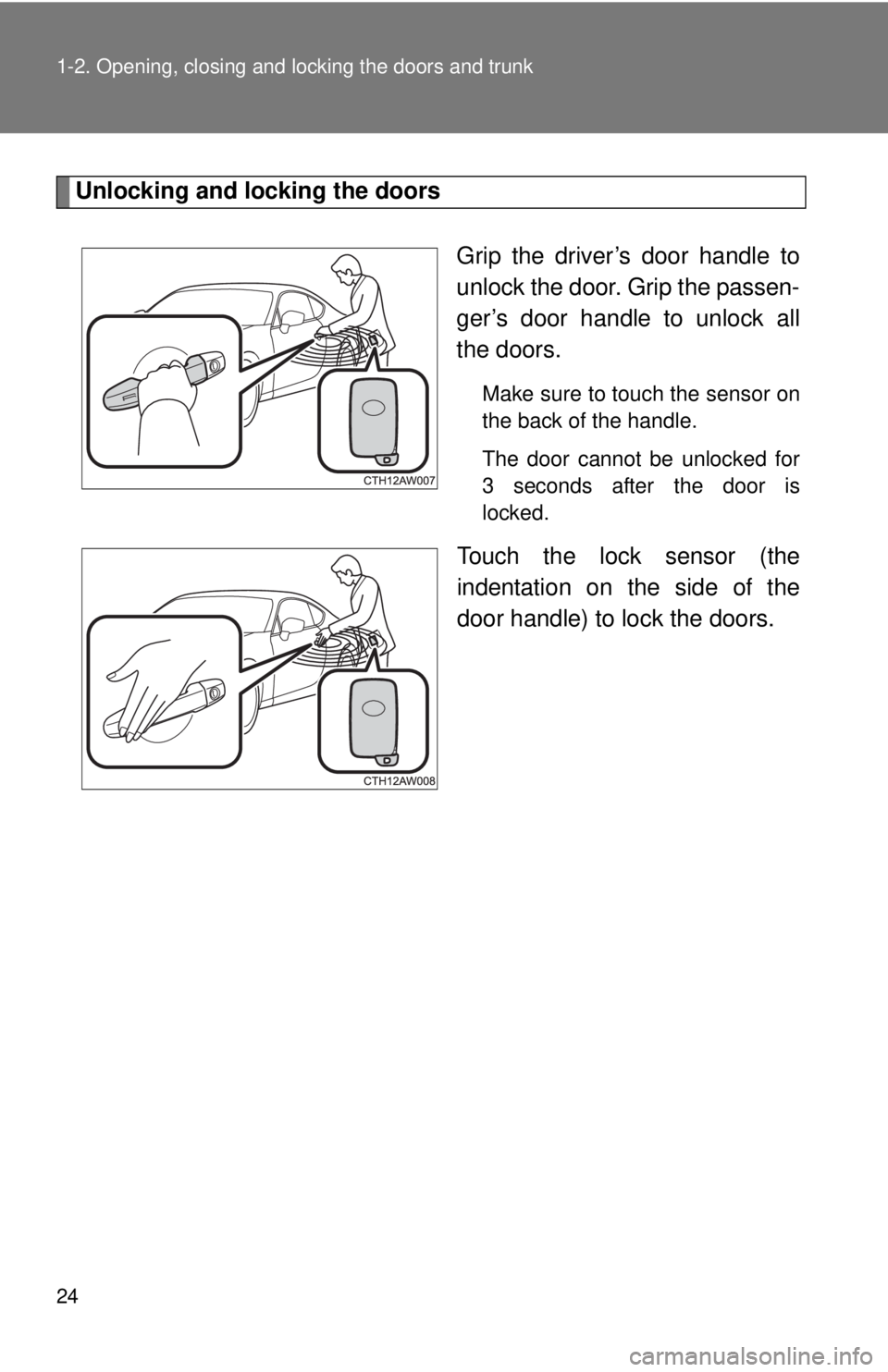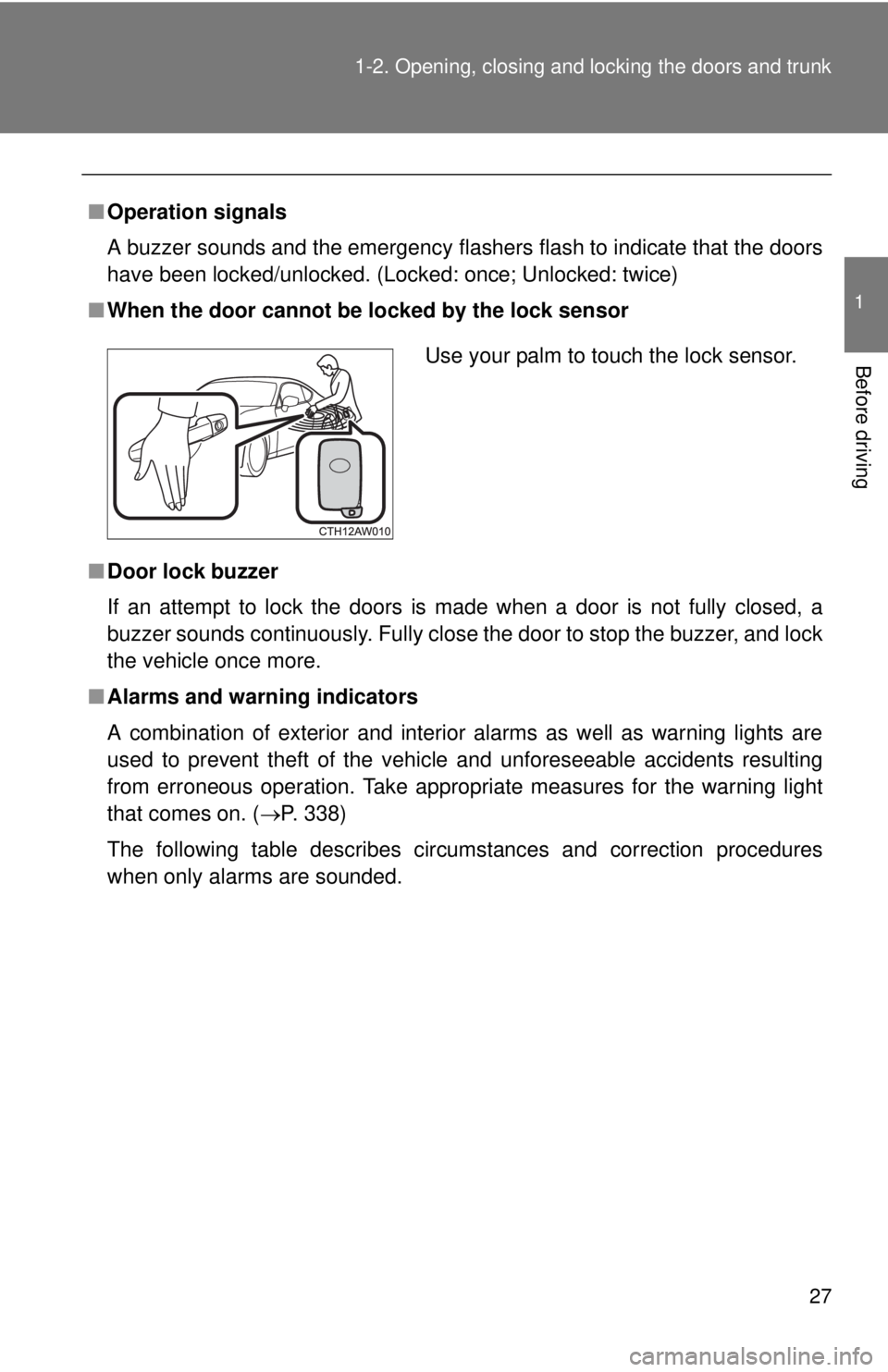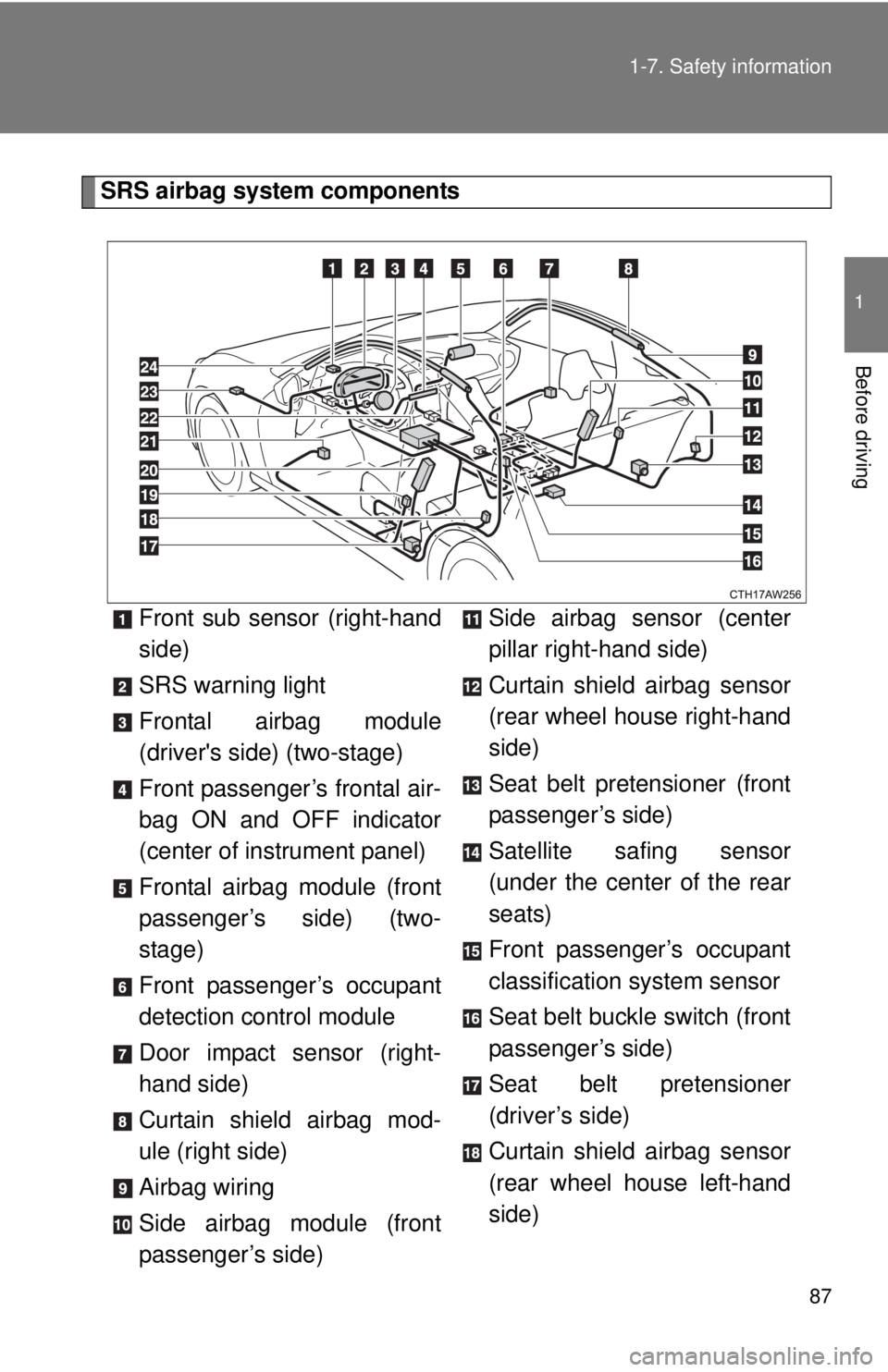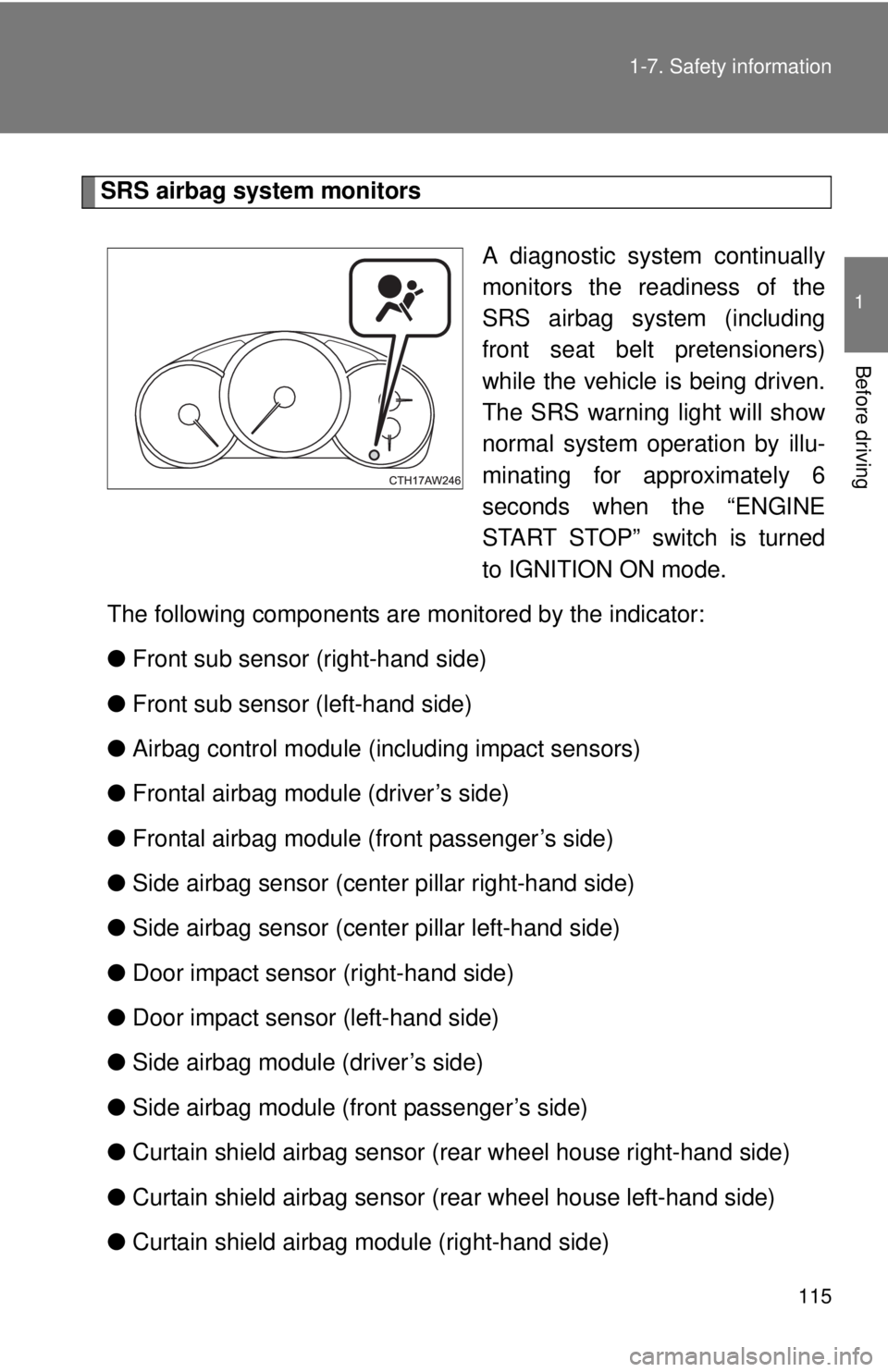sensor TOYOTA FR-S 2013 Owners Manual (in English)
[x] Cancel search | Manufacturer: TOYOTA, Model Year: 2013, Model line: FR-S, Model: TOYOTA FR-S 2013Pages: 448, PDF Size: 5.59 MB
Page 24 of 448

24 1-2. Opening, closing and locking the doors and trunk
Unlocking and locking the doorsGrip the driver’s door handle to
unlock the door. Grip the passen-
ger’s door handle to unlock all
the doors.
Make sure to touch the sensor on
the back of the handle.
The door cannot be unlocked for
3 seconds after the door is
locked.
Touch the lock sensor (the
indentation on the side of the
door handle) to lock the doors.
Page 27 of 448

27
1-2. Opening, closing and locking the doors and trunk
1
Before driving
■
Operation signals
A buzzer sounds and the emergency flashers flash to indicate that the doors
have been locked/unlocked. (Locked: once; Unlocked: twice)
■ When the door cannot be locked by the lock sensor
■ Door lock buzzer
If an attempt to lock the doors is made when a door is not fully closed, a
buzzer sounds continuously. Fully close the door to stop the buzzer, and lock
the vehicle once more.
■ Alarms and warning indicators
A combination of exterior and interior alarms as well as warning lights are
used to prevent theft of the vehicle and unforeseeable accidents resulting
from erroneous operation. Take appropria te measures for the warning light
that comes on. ( P. 338)
The following table describes circumstances and correction procedures
when only alarms are sounded.
Use your palm to touch the lock sensor.
Page 32 of 448

32 1-2. Opening, closing and locking the doors and trunk
■Notes for locking the doors
●Touching the door lock sensor while wearing gloves may delay or prevent
lock operation. Remove the gloves and touch the lock sensor again.
● When the lock operation is performed using the lock sensor, recognition
signals will be shown up to two consecutive times. After this, no recogni-
tion signals will be given.
● If the door handle becomes wet when washing the vehicle while the elec-
tronic key is within the effective range, the door may lock and unlock
repeatedly. In this case, place the electronic key in a location 6 ft. (2 m) or
more away from the vehicle (take care to ensure that the key is not sto-
len), and continue to wash the vehicle.
● If the electronic key is inside the vehicle and a door handle becomes wet
during a car wash, a buzzer will sound outside the vehicle. To turn off the
alarm, lock all the doors.
● The lock sensor may not work properly if it comes into contact with ice,
snow, mud, etc. Clean the lock sensor and attempt to operate it again.
■ Notes for the unlocking function
●A sudden approach to the effective range or door handle may prevent the
doors from being unlocked. In this case, return the door handle to the
original position and check that the doors unlock before pulling the door
handle again.
● Gripping the door handle when wearing a glove may not unlock the door.
Remove the gloves and touch the sensor on the back of the handle
again.
● If the door handle becomes wet when washing the vehicle while the elec-
tronic key is within the effective range, the door may lock and unlock
repeatedly. In this case, place the electronic key in a location 6 ft. (2 m) or
more away from the vehicle (take care to ensure that the key is not sto-
len), and continue to wash the vehicle.
● If there is another electronic key in the detection area, it may take slightly
longer to unlock the doors after the door handle is gripped.
Page 87 of 448

87
1-7. Safety information
1
Before driving
SRS airbag system components
Front sub sensor (right-hand
side)
SRS warning light
Frontal airbag module
(driver's side) (two-stage)
Front passenger’s frontal air-
bag ON and OFF indicator
(center of instrument panel)
Frontal airbag module (front
passenger’s side) (two-
stage)
Front passenger’s occupant
detection control module
Door impact sensor (right-
hand side)
Curtain shield airbag mod-
ule (right side)
Airbag wiring
Side airbag module (front
passenger’s side) Side airbag sensor (center
pillar right-hand side)
Curtain shield airbag sensor
(rear wheel house right-hand
side)
Seat belt pretensioner (front
passenger’s side)
Satellite safing sensor
(under the center of the rear
seats)
Front passenger’s occupant
classification system sensor
Seat belt buckle switch (front
passenger’s side)
Seat belt pretensioner
(driver’s side)
Curtain shield airbag sensor
(rear wheel house left-hand
side)
Page 88 of 448

88 1-7. Safety information
Your vehicle is equipped with ADVANCED AIRBAGS designed based
on US motor vehicle safety standards (FMVSS208). The airbag sys-
tem controls airbag deployment po wer for the driver and front pas-
senger. The front passenger's airbag system consists of the front
passenger occupant dete ction control module etc.
The main SRS airbag system components are shown above. The
SRS airbag system is controlled by the airbag control module. The
airbag control module consis ts of an airbag sensor.
In certain types of severe front or side impacts, the SRS airbag sys-
tem triggers the airbag inflators. A chemical reaction in the inflators
quickly fills the airbags with non-toxic gas to help restrain the motion
of the occupants.
Side airbag sensor (center
pillar left-hand side)
Side airbag module (driver’s
side)
Door impact sensor (left-
hand side) Airbag control module
(including impact sensors)
Front sub sensor (left-hand
side)
Curtain shield airbag mod-
ule (left side)
■
If the SRS airbags deploy (inflate)
●Bruising and slight abrasions may result from contact with a deploying
(inflating) SRS airbag.
● A loud noise and white powder will be emitted.
● Parts of the airbag module (steering wheel hub, airbag cover and inflator)
as well as the front seats, parts of the front and rear pillars, and roof side
rails, may be hot for several minutes. The airbag itself may also be hot.
● The windshield may crack.
Page 90 of 448

90 1-7. Safety information
■Driver’s SRS frontal airbag
The driver’s SRS frontal airbag uses a dual stage inflator. The inflator oper-
ates in different ways depending on the severity of impact.
Have the system inspected by your Scion dealer immediately if the SRS
warning light illuminates.
NOTE
The driver’s SRS side airbag and SRS curtain shield airbag are not con-
trolled by the Scion advanced frontal airbag system.
■ Front passenger’s SRS frontal airbag
The front passenger’s SRS frontal airbag uses a dual stage inflator. The
inflator operates in different ways depending on the severity of impact.
The occupant classification system sensor is installed under the seat uphol-
stery and monitors the physique and posture of the front passenger. Using
this information, the occupant classification system determines whether the
front passenger’s SRS frontal airbag should be deployed or not.
The occupant classification system may not inflate the front passenger’s
SRS frontal airbag even when the driver’s SRS frontal airbag deploys. This
is normal. In this case, although the front passenger’s SRS frontal airbag
does not operate, the front passenger’s seat belt pretensioner operates with
the driver’s seat belt pretensioner. For details about the seat belt preten-
sioner, refer to “Seat belt pretensioners”. ( P. 55)
Observe the following precautions. Failure to do so may prevent the Scion
advanced frontal airbag system from functioning correctly or cause the sys-
tem to fail.
● Do not apply any strong impact to the front passenger’s seat.
● Do not spill liquid on the front passenger’s seat. If liquid is spilled, wipe it
off immediately.
● Do not remove or disassemble the front passenger’s seat.
● Do not install any accessory (such as an audio amplifier) other than a
genuine Scion accessory under the front passenger’s seat.
● Do not place anything (shoes, umbrella, etc.) under the front passenger’s
seat.
● Do not place a magnet near the seat belt buckle.
Page 91 of 448

91
1-7. Safety information
1
Before driving
If the seat belt buckle switch and/or front passenger’s occupant classification
system have failed, the SRS warning light will illuminate. Have the system
inspected by your Scion dealer immediately if the SRS warning light illumi-
nates.
If your vehicle has sustained impact, this may affect the proper function of
the Scion advanced frontal airbag system. Have your vehicle inspected at
your Scion dealer. Do not use the front passenger’s seat while driving the
vehicle to your Scion dealer.
NOTE
The front passenger’s SRS side airbag and SRS curtain shield airbag are
not controlled by the Scion advanced frontal airbag system.
■ Passenger’s frontal airbag ON and OFF indicators
P. 1 1 7
■ Occupant classification system
The occupant classification system sensor is installed under the seat uphol-
stery and monitors the physique and posture of the front passenger. Using
this information, the occupant classification system determines whether the
front passenger’s SRS frontal airbag should be deployed or not.
If the front passenger’s seat cushion is wet, this may adversely affect the
ability of the system to determine deployment. If the seat cushion is wet, the
front passenger should stop sitting on the front passenger’s seat. Wipe off
liquid from the seat immediately, let the seat dry naturally and then check the
SRS warning light as follows.
●If the SRS warning light illuminates, keep the seat dry until the warning
light turns off. If the SRS warning light stays on even when the seat has
dried, do not allow anyone to sit on the front passenger’s seat and have
the system checked by your Scion dealer.
● If the SRS warning light does not illuminate, check that the front passen-
ger’s frontal airbag ON and OFF indicators work properly. If the indicators
do not work properly, do not allow anyone to sit on the front passenger’s
seat and have the system checked by your Scion dealer.
Page 97 of 448

97
1-7. Safety information
1
Before driving
The SRS airbag can function only when the “ENGINE START STOP” switch
is in IGNITION ON mode.
The Scion advanced frontal airbag system is designed to determine the acti-
vation or deactivation condition of the front passenger’s SRS frontal airbag
depending on the characteristic of the item(s) or person on the front passen-
ger’s seat monitored by the front passenger’s occupant classification system
sensor. For this reason, only the driver’s SRS frontal airbag may deploy in
the event of a collision, but this does not mean failure of the system.
If the front sub sensors and the impact sensors in the airbag control module
detect a predetermined amount of force during a frontal collision, the control
module sends signals to the airbag modu
le(s) (only driver’s module or both
driver’s and front passenger’s modules) instructing the module(s) to inflate
the SRS frontal airbag(s).
The driver’s and front passenger’s SRS frontal airbags use dual stage infla-
tors. The two inflators of each airbag are triggered either sequentially or
simultaneously, depending on the severity of impact, in the case of the
driver’s SRS frontal airbag and depending on the severity of impact and the
characteristic of the item(s) or person on the seat in the case of the front
passenger’s SRS frontal airbag.
After deployment, the SRS airbag immediately starts to deflate so that the
driver’s vision is not obstructed. The time required from detecting impact to
the deflation of the SRS airbag after deployment is shorter than the blink of
an eye.
Both when only the driver’s SRS frontal airbag deploys and the driver’s and
front passenger’s SRS frontal airbags deploy, the driver’s and front passen-
ger’s seat belt pretensioners operate at the same time.
Although it is highly unlikely that the SRS airbag would activate in a non-
accident situation, should it occur, the SRS airbag will deflate quickly, not
obscuring vision and will not interfere with the driver's ability to maintain con-
trol of the vehicle.
When the SRS airbag deploys, a sudden, fairly loud inflation noise will be
heard and some smoke will be released. These occurrences are a normal
result of the deployment. This smoke does not indicate a fire in the vehicle.
Page 104 of 448

104 1-7. Safety information
■Operation
The SRS side airbag and SRS curtain shield airbag can function only when
the “ENGINE START STOP” switch is in IGNITION ON mode.
The driver’s and front passenger’s SRS side airbags and SRS curtain shield
airbags deploy independently of each other since each has its own impact
sensor. Therefore, they may not both deploy in the same accident. Also, the
SRS side airbag and SRS curtain shield airbag deploys independently of the
driver’s and front passenger’s SRS front airbags in the steering wheel and
instrument panel.
An impact sensor, which senses impact force, is located in each of the left
and right center pillars, doors and rear wheel houses. Another impact sen-
sor, which also senses impact force, is located under the center of the rear
seats.
If the impact sensor that is located under the center of the rear seats and
one of the center pillar impact sensors or door impact sensors together
sense an impact force above a predetermined level in a side collision, the
control module causes both the SRS side airbag and curtain shield airbag on
the impacted side to inflate regardless of whether the rear wheel house
impact sensor on the same side senses an impact.
If the impact sensor that is located under the center of the rear seats and
one of the rear wheel house impact sensors together sense an impact force
above a predetermined level, the control module causes only the SRS cur-
tain shield airbag on the impacted side to inflate.
After the deployment, the SRS side airbag immediately starts to deflate. The
time required from detection of an impact to deflation of an SRS side airbag
after deployment is shorter than the blink of an eye.
Page 115 of 448

115
1-7. Safety information
1
Before driving
SRS airbag system monitors
A diagnostic system continually
monitors the readiness of the
SRS airbag system (including
front seat belt pretensioners)
while the vehicle is being driven.
The SRS warning light will show
normal system operation by illu-
minating for approximately 6
seconds when the “ENGINE
START STOP” switch is turned
to IGNITION ON mode.
The following components are monitored by the indicator:
● Front sub sensor (right-hand side)
● Front sub sensor (left-hand side)
● Airbag control module (including impact sensors)
● Frontal airbag module (driver’s side)
● Frontal airbag module (front passenger’s side)
● Side airbag sensor (center pillar right-hand side)
● Side airbag sensor (center pillar left-hand side)
● Door impact sensor (right-hand side)
● Door impact sensor (left-hand side)
● Side airbag module (driver’s side)
● Side airbag module (front passenger’s side)
● Curtain shield airbag sensor (rear wheel house right-hand side)
● Curtain shield airbag sensor (rear wheel house left-hand side)
● Curtain shield airbag module (right-hand side)